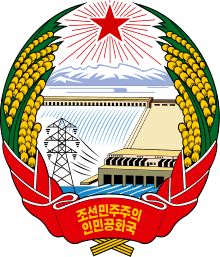North Korea–Romania relations
.png) | |
North Korea |
Romania |
|---|---|
| Diplomatic Mission | |
| DPRK Embassy, Bucharest | Embassy of Romania, Pyongyang |
| Envoy | |
| Kim Son Gyong | Ambassador Andy Avram, Chargé d'Affaires a.i. |
The Democratic People's Republic of Korea (DPRK) and Romania have maintained limited relations since the Romanian Revolution of 1989. Relations between the two countries began on October 26, 1948, when Romania was part of the Eastern Bloc. Romania has an embassy in Pyongyang and North Korea has an embassy in Bucharest.
Historical overview
The Romanian People's Republic formally recognized the Democratic People's Republic of Korea on October 26, 1948 as the sole legitimate government of the entire Korean Peninsula. Both countries were allies during the Korean War in the early-1950s.[1]

On July 15, 1971, the president of the newly-renamed Socialist Republic of Romania, Nicolae Ceaușescu, visited North Korea[2][3][4] He took great interest in the idea of total national transformation as embodied in the programs of the Workers' Party of Korea. He was also inspired by the personality cult of Kim Il-sung. Shortly after returning home, he began to emulate North Korea's system, influenced by Kim's Juche philosophy. According to the British journalist Edward Behr, Ceaușescu admired Kim as a leader because he dominated his nation and broke free from Soviet control, combining totalitarian methods with ultra-nationalist and communist ideologies. [5] Behr wrote that the possibility for "vast Potemkin villages for the hoodwinking of gullible foreign guests" that Ceaușescu had seen in North Korea was something that never seemed to have crossed his mind before.[5]
Upon his return to Romania, Ceausescu began to emulate North Korea's system. He issued the July Theses, a set of proposals that tightened government control over Romanian media, promoted nationalism, and intensified his personality cult. North Korean books on Juche were translated into Romanian and widely distributed inside the country.
Post-Communist Romania
Relations between North Korea and Romania became strained after Romania's Communist government fell. Ceausescu's execution during the 1989 Romanian Revolution and the 1991 dissolution of the Soviet Union resulted in Romania rejecting the totalitarian ideologies the North Korean government still promotes. Romania allied itself with nations hostile to the DPRK: it established relations with North Korea's rival the Republic of Korea (South Korea) on March 30, 1990, entered NATO in 2004, and joined the European Union in 2007.[6]
In 2016, the Romanian Foreign Affairs ministry reacted to North Korea's hydrogen bomb test that occurred in January with a statement of concern that this test posed "... a challenge to peace and security in the region".[7]
See also
References
- ↑ https://www.wilsoncenter.org/event/romanias-fraternal-support-to-north-korea-during-the-korean-war-1950-1953
- ↑
- Cioroianu, Adrian, Pe umerii lui Marx. O introducere în istoria comunismului românesc ("On the Shoulders of Marx. An Incursion into the History of Romanian Communism"), Editura Curtea Veche, Bucharest, 2005, ISBN 973-669-175-6, p. 489.
- ↑ Tismăneanu, Vladimir, Stalinism pentru eternitate, Polirom, Iași, 2005 ISBN 973-681-899-3 (translation of Stalinism for All Seasons: A Political History of Romanian Communism, University of California Press, Berkeley, 2003, ISBN 0-520-23747-1), p. 2412.
- ↑ Minutes of the Romanian Politburo Meeting Concerning Nicolae Ceaușescu's Visit to China, North Korea, Mongolia, and Vietnam Archived 2016-01-20 at the Wayback Machine., Parallel History Project on Cooperative Security
- 1 2 Behr, Edward Kiss the Hand You Cannot Bite, New York: Villard Books, 1991 page 195.
- ↑ http://articles.latimes.com/1990-01-07/news/mn-174_1_north-korea
- ↑ no by-line (2016-06-01). "MFA position on Democratic People's Republic of Korea claim of hydrogen bomb test" (Press release). Romania: Ministry of Foreign Affairs, Romania. Retrieved 2017-07-19.

